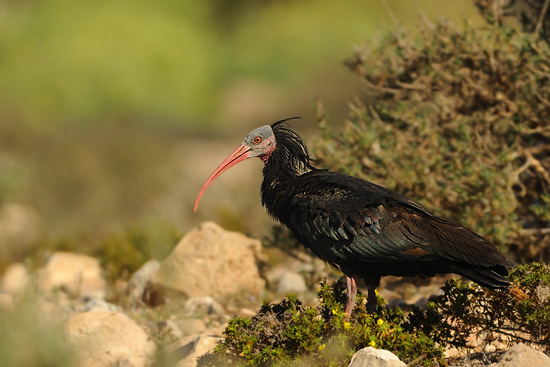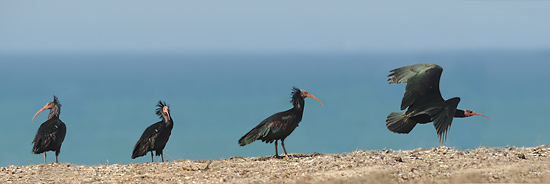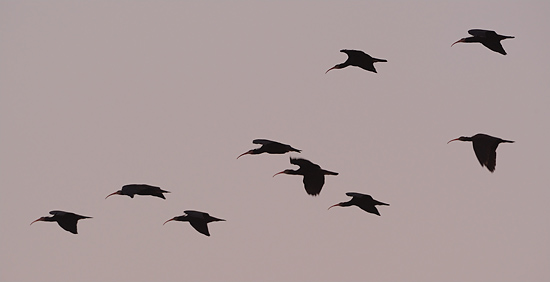Northern Bald Ibis, Geronticus eremite, is an almost mythical species of the wide Mediterranean area. In spite of it’s weird appearance, the bird shows some striking features such as it’s huge curved red bill. When observed at close range, it’s plumage reveals subtle purple, blue and green metallic colours on the wings and back. Unlike most of the Ibis species, the Northern Bald Ibis is not a typical wetland species, but requires mainly steppe and semi-desert areas, where it demands large foraging areas. It is a large and sociable bird, which breeds in big colonies and forages in large groups. This social pattern and particularly the dependency on large numbers for surviving, makes the species vulnerable. Another limiting factor in the bird’s distribution is the presence of high and steep cliffs, where colonies can settle down for breeding or roosting and where the birds are kept safe from predators. The Ibis has a broad diet, feeding on any available animal-life including insects, arachnids, scorpions, earthworms, snails and vertebrates such as fish, lizards and snakes, small rodents and small birds, whether alive or dead.

Although the Moroccan population of the Northern Bald Ibis has recently stabilized and even increased a little bit, the bird has still an extremely limited range, which represents only a fraction of it’s former distribution. Therefore the species is still considered by IUCN as Critically endangered. A catastrophe in one of the few breeding colonies, or severe declines of the numbers, might still bring the species on the verge of extinction.Once the species had a wide distribution in a large area around the entire Mediterranean sea. The species appears on the Egyptian hieroglyphs and was once widespread in the European Alps. The species already disappeared 400 years ago in the Alps, possibly due to overhunting and collection of eggs and nestlings of this confiding species. In Egypt the last colony disappeared around 1900. In the 20th century there were still two populations, of which one across East African and one across the Middle East. The use of pesticides, the conversion of extensively grazed steppe habitats into more intensely grazed or intensively managed farmland, caused severe declines of both populations. By the end of the seventies there were only a tiny Moroccan and Turkish population left.

The Birecik (Turkey) population died out in the wild by the end of the nineties and in 2000 the wild population of the eastern birds was thought to be definitively extinct. In 2002 a tiny colony in Palmyra, Syria was discovered and the birds were then tagged. The satellite tagging revealed that this population migrates south through Jordan and Saudi Arabia, Yemen and then winter in Ethiopia. The birds migrated back to Eritrea and Sudan. Between 2004 and 2007 only five immature birds returned to the colony and in 2008, breeding failed. Records of untagged birds in Israel and Djibouti, may relate to immature birds from the Syrian colony, but could also belong to a yet undiscovered population. Meanwhile a captive breeding program of the Turkish birds proved to be successful and the birds were released in Birecik again. Because a lot of the Ibises seem to die on their migration routes, the Birecik population is still kept ‘semi-captive’: birds are free flying for five months, breeding on natural nest sites and nest-boxes in cliffs, but are taken into captivity after the breeding season. Three birds from the colony migrated in 2009 travelling via the Palmyra site. Unfortunately they were later found dead in Jordan.

The history of the Moroccan population is a little bit less dramatic, but still worrying, because the breeding colonies are still limited to the cliffs in Sous Massa National Park and the Tamri area. In 1995, the Moroccan population was estimated at 300 individuals (74 breeding pairs that laid eggs). In 1998, it had declined to 59 pairs, following the mysterious death of 40 birds in 1996, but by 2006 there were 95 pairs that laid eggs. Importantly, since 1980 there has been no overall decline in numbers at Souss Massa National Park. Growing numbers, and good productivity (over 500 birds in the Moroccan population after the breeding season in recent years) give cause for optimism that former areas may soon be recolonised.
